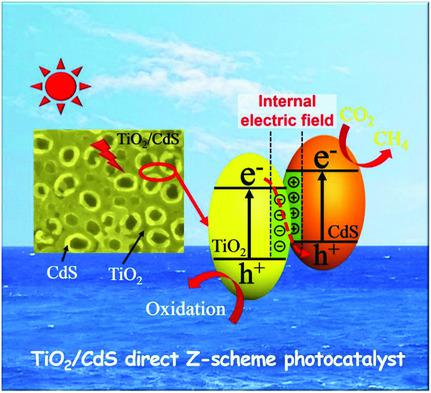当前位置:
X-MOL 学术
›
Adv. Mater.
›
论文详情
Our official English website, www.x-mol.net, welcomes your
feedback! (Note: you will need to create a separate account there.)
In Situ Irradiated X‐Ray Photoelectron Spectroscopy Investigation on a Direct Z‐Scheme TiO2/CdS Composite Film Photocatalyst
Advanced Materials ( IF 27.4 ) Pub Date : 2018-10-21 , DOI: 10.1002/adma.201802981 Jingxiang Low 1 , Benzhe Dai 1 , Tong Tong 1 , Chuanjia Jiang 2 , Jiaguo Yu 1, 3
Advanced Materials ( IF 27.4 ) Pub Date : 2018-10-21 , DOI: 10.1002/adma.201802981 Jingxiang Low 1 , Benzhe Dai 1 , Tong Tong 1 , Chuanjia Jiang 2 , Jiaguo Yu 1, 3
Affiliation

|
Inspired by nature, artificial photosynthesis through the construction of direct Z‐scheme photocatalysts is extensively studied for sustainable solar fuel production due to the effectiveness in enhancing photoconversion efficiency. However, there is still a lack of thorough understanding and direct evidence for the direct Z‐scheme charge transfer in these photocatalysts. Herein, a recyclable direct Z‐scheme composite film composed of titanium dioxide and cadmium sulfide (TiO2/CdS) is prepared for high‐efficiency photocatalytic carbon dioxide (CO2) reduction. In situ irradiated X‐ray photoelectron spectroscopy (ISI‐XPS) confirms the direct Z‐scheme charge‐carrier migration pathway in the photocatalytic system. Furthermore, density functional theory simulation identifies the intrinsic cause for the formation of the direct Z‐scheme heterojunction between the TiO2 and the CdS. Thanks to the significantly enhanced redox abilities of the charge carriers in the direct Z‐scheme system, the photocatalytic CO2 reduction performance of the optimized TiO2/CdS is 3.5, 5.4, and 6.3 times higher than that of CdS, TiO2, and commercial TiO2 (P25), respectively, in terms of methane production. This work is a valuable guideline in preparation of highly efficient recyclable nanocomposite for photoconversion applications.
中文翻译:

Z型TiO2 / CdS复合薄膜光催化剂的原位X射线光电子能谱研究
受自然界的启发,通过直接Z方案光催化剂的构建来进行人工光合作用,由于其在提高光转化效率方面的有效性而被广泛研究用于可持续的太阳能燃料生产。但是,对于这些光催化剂中直接Z方案电荷的转移,仍然缺乏透彻的理解和直接的证据。在此,制备了由二氧化钛和硫化镉(TiO 2 / CdS)组成的可循环使用的直接Z方案复合膜,用于高效光催化二氧化碳(CO 2) 减少。原位辐射X射线光电子能谱(ISI-XPS)证实了光催化系统中Z方案直接的载流子迁移路径。此外,密度泛函理论模拟确定了在TiO 2和CdS之间直接形成Z型异质结的内在原因。由于直接Z方案系统中电荷载流子的氧化还原能力显着增强,优化后的TiO 2 / CdS的光催化CO 2还原性能比CdS,TiO 2和CdS分别高3.5、5.4和6.3倍。商业TiO 2(P25)分别以甲烷产量计。这项工作是制备用于光转换应用的高效可回收纳米复合材料的宝贵指导。
更新日期:2018-10-21
中文翻译:

Z型TiO2 / CdS复合薄膜光催化剂的原位X射线光电子能谱研究
受自然界的启发,通过直接Z方案光催化剂的构建来进行人工光合作用,由于其在提高光转化效率方面的有效性而被广泛研究用于可持续的太阳能燃料生产。但是,对于这些光催化剂中直接Z方案电荷的转移,仍然缺乏透彻的理解和直接的证据。在此,制备了由二氧化钛和硫化镉(TiO 2 / CdS)组成的可循环使用的直接Z方案复合膜,用于高效光催化二氧化碳(CO 2) 减少。原位辐射X射线光电子能谱(ISI-XPS)证实了光催化系统中Z方案直接的载流子迁移路径。此外,密度泛函理论模拟确定了在TiO 2和CdS之间直接形成Z型异质结的内在原因。由于直接Z方案系统中电荷载流子的氧化还原能力显着增强,优化后的TiO 2 / CdS的光催化CO 2还原性能比CdS,TiO 2和CdS分别高3.5、5.4和6.3倍。商业TiO 2(P25)分别以甲烷产量计。这项工作是制备用于光转换应用的高效可回收纳米复合材料的宝贵指导。











































 京公网安备 11010802027423号
京公网安备 11010802027423号